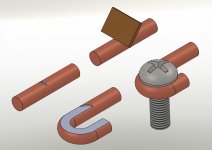RossS
Member
- Location
- Research Triangle, NC USA
- Occupation
- Electrical engineer
Having spent the better part of the afternoon trying to chase this down and basically getting nowhere, I thought I'd post this here.
There's a ton of opinion out there, and a whole lot of it is consistent with my own opinion that push-in type connections are not as electrically or mechanically sound as screw type, including wire nuts. But when I went looking for actual evidence, you know, like studies and such by groups that get paid to destroy stuff, I came up empty.
Can anyone point me to an actual study, preferably by a nationally recognized testing laboratory, of how well push-in type connections perform and whether they tend to overheat under higher load conditions?
There's a ton of opinion out there, and a whole lot of it is consistent with my own opinion that push-in type connections are not as electrically or mechanically sound as screw type, including wire nuts. But when I went looking for actual evidence, you know, like studies and such by groups that get paid to destroy stuff, I came up empty.
Can anyone point me to an actual study, preferably by a nationally recognized testing laboratory, of how well push-in type connections perform and whether they tend to overheat under higher load conditions?


